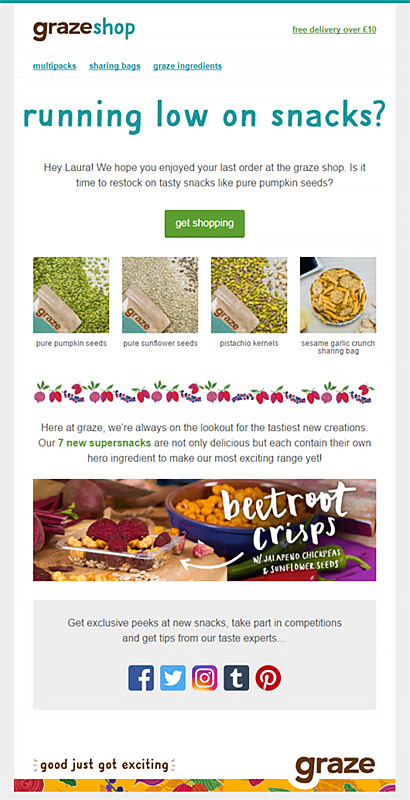As an eCommerce, you are presumably working hard to capture as much data about your customer and site visitors as possible. This data is gold dust, as it allows you to directly contact the individuals who are most engaged with your brand and your products. Once you gather your data, you can start creating segments within your audience –based on behaviour, history, or demographic–, and use them for your email marketing campaigns.
One thing you may not be aware of about your products is that your customers may have a recurring need to buy them. If you are selling household goods, grooming items, even clothes, such as basic staples like underwear and socks, the chances are that your customers will need to buy these items again and again, as and when they run out.
How to guarantee a regular revenue stream thanks to those items? By sending replenishment emails: a gentle reminder to your customers, via email, push notification or both, to buy those “must-have products” before they run out. According to Ometria, replenishment emails have an average open rate of 50-60% and an average click-rate of 40-50%.
The process is straightforward: Look at the dates a customer ordered products from your brand, plot the time those products will likely run out or need to be replenished and send those customers an email reminder to do so. Through this strategy, you are predicting and addressing a need your customer has (consumption of a particular good) and relieving that need by reminding your customer to purchase more of the same product.
Value and retention are key in eCommerce when it comes to run any successful online site. By retaining existing customers through replenishment emails, you can begin to plan long-term and even take this opportunity to promote other categories or any brand content.
Knowing you are retaining customers who are buying the same things from you on a reoccurring basis, means that you can better forecast the demand for your raw materials, necessarily, solving your inventory problem. Besides, by analysing the results of these emails, you can also revenue forecasts more accurate and your business will run like a well-oiled machine.
How to send your replenishment emails
In terms of the actual process of sending your replenishment emails, timing is critical. You need to know when your products usually run out. For example, if you aren’t sure, you can send a short survey to your customers, asking them when they run out of the items you sell. Once you have the timeline, you can set up marketing automation to be sent out around that timeline.
In terms of content, your replenishment emails will be most effective if you pinpoint the needs of your consumers while highlighting the benefits of buying your products instead of competitors’. If you understand the “why” that motivates your customers, then you can use this to your advantage. Make re-ordering as simple as possible by reducing the number of steps. Maybe let your consumers select re-order right from the email, or hyperlink the first and second calls to action.
Replenishment emails are one of the most effective ways to implement personalisation in your marketing communications. Not only you can predict a pattern and act on it, but you are also addressing your customers’ needs without them telling you to do so. It’s a win-win situation: you can encourage sales, increase your revenue and retain your existing customers.









